Biological Science Faculty Member
Dr. Gregory M. Erickson
- Office: 4011 King Life Sciences
- Office: (850) 645-4991
- Area: Ecology & Evolution
- Lab: 4012
- E-mail: gerickson@bio.fsu.edu
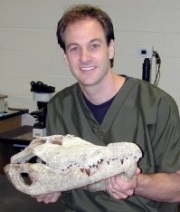
Professor of Anatomy and Vertebrate Paleobiology
Curator, Florida State University Biological Science Museum
Co-Director of the Paleo-Arctic Research Consortium
Fellow of the American Association for the Advancement of Science
Appointed to the International Union for the Conservation of Nature--Crocodilian Specialist Group
National Geographic Explorer
Ph.D., Integrative Biology, University of California, Berkeley, 1997.
NSF Postdoctoral Fellow, Department of Biomechanical Engineering, Stanford University, 1998-1999.
NSF Postdoctoral Fellow, Department of Ecology and Evolutionary Biology, Brown University, 1999-2000.
Research Associate: American Museum of Natural History, New York; The Field Museum, Chicago; University of Alaska Museum of the North, Fairbanks
Graduate Faculty Status
Crocodile Bite Force Press Materials
Hadrosaurid Data
Former Research Projects
Tyrannosaur Press Materials [Science Magazine]
Former Research Projects 2
Research on the evolution of dinosaurian and avian growth rates funded by the National Science Foundation
Data Archive - Erickson
CVA Exam Prep Lectures
Research and Professional Interests:
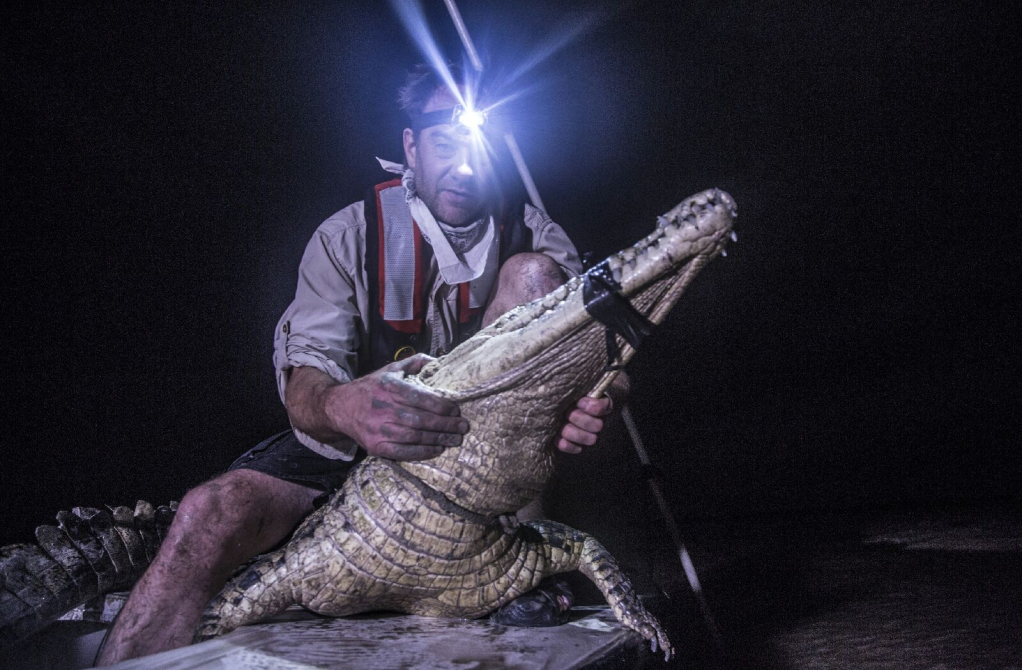
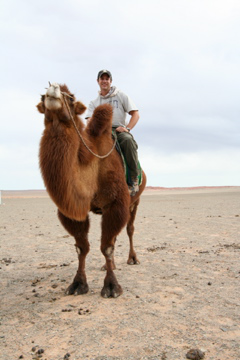
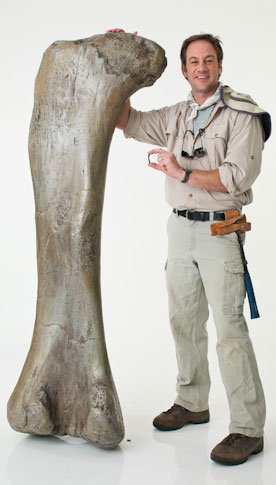
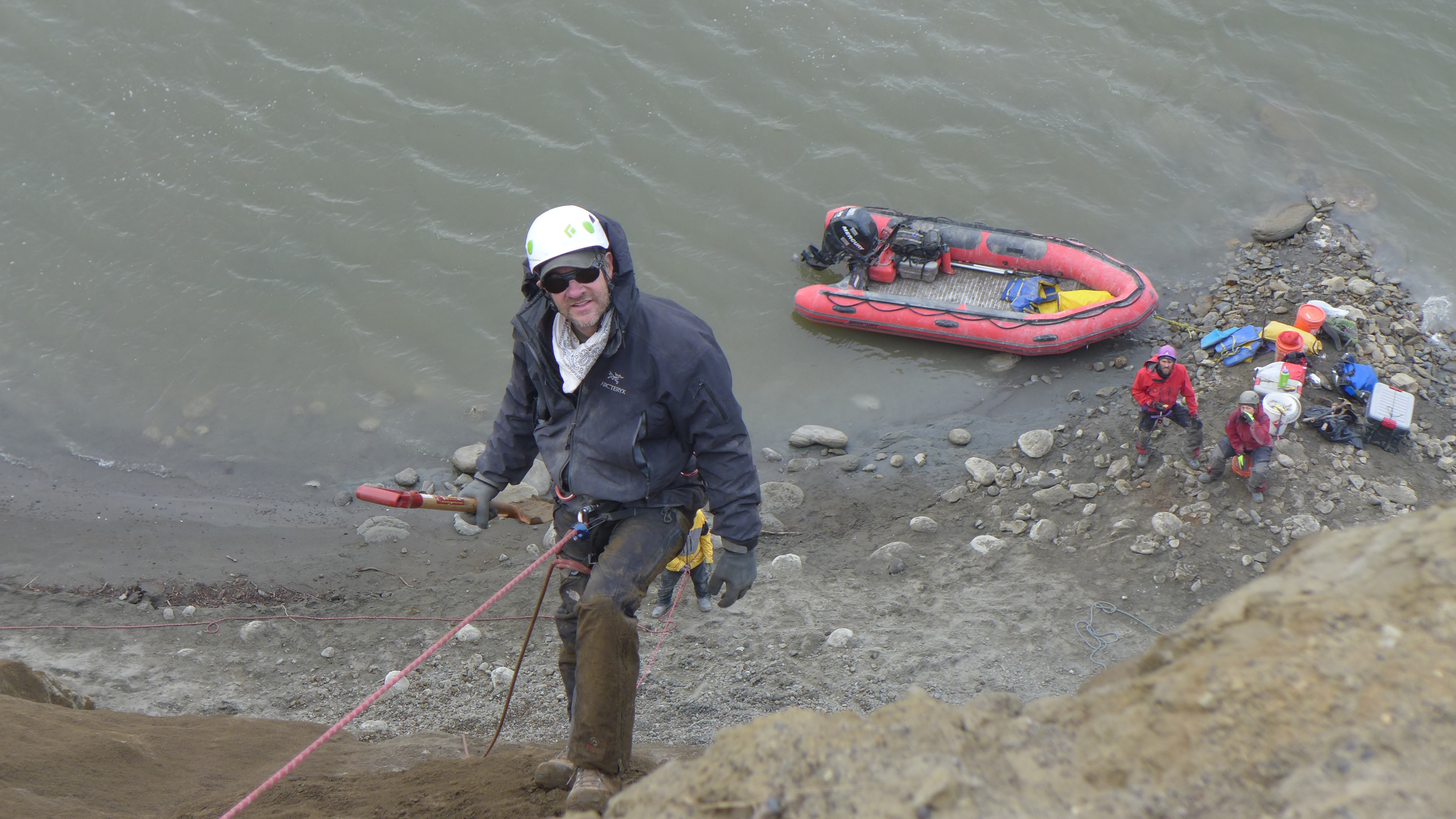 Photo:Chris McEniry
Photo:Chris McEniry
My primary area of expertise is evolutionary paleobiology, archosaurian reptiles (crocodiles, non-avian and avian dinosaurs (birds), and pterosaurs) in particular. I also have ancillary interests in the evolution of terrestrial oxudercine gobies (mudskippers). The major focus of my research is the form, function, performance, and development of the musculo-skeletal system from which inferences on life history, physiology, biomechanics, and ecology are drawn. This provides new and novel insights into the most important radiations in earth history (e.g. the 85-million year domination of predatory niches at the water-land interface by crocodilians, the evolution of gigantism and diversification of dinosaurs, the evolution of avian flight, the evolution of dental occlusion and diversification in herbivorous reptiles, and the vertebrate conquest of land). I employ phylogenetic principles and methods from several traditional fields of study--including geology, anatomy, mechanical and material science engineering, physiology, ecology, developmental biology, and vertebrate anatomy--to address unique cross-disciplinary paleobiological questions. My general approach to these questions is to conduct extensive testing on extant systems prior to implementation on fossil taxa. I typically collaborate with a diversity of researchers from different fields and research institutions, both domestically and internationally, in China, Mongolia, Germany, Spain, Romania, Canada, England, Australia, and Argentina. In addition, I am the co-director of the Paleo-Arctic Research Consortium and have an active NSF-funded field program in the Early Maastrichtian Prince Creek Formation on Alaska’s North Slope studying the vertebrate fauna to better understand how these animals flourished under extreme environmental conditions at 85 degrees North paleolatitude. I also conduct neontological fieldwork throughout Florida and overseas garnering data on crocodilian feeding biomechanics, and in southern latitudes collecting and studying mudskipper locomotion. Finally, I am a TV presenter and host for documentaries on predatory animals (crocodilians in particular) and dinosaurs, consultant for permanent museum exhibits, and senior scientific advisor for children’s books and travelling animatronics exhibitions on prehistoric animals.
I teach courses on: Human gross Anatomy, Comparative evolutionary vertebrate anatomy, Evolutionary morphology, Herpetology, and the Paleobiology of dinosaurs. In my research program I am currently studying:
1. Means to assess longevity and growth rates in extinct and living reptiles (e.g. dinosaurs, crocodilians, lizards) using skeletal growth markers and the use of these data for inferring heterochronic patterns. These data are further used to reconstruct aspects of ancient population biology and ecology.
Major findings/advancements to date include:
-
Generating the first mass-age growth curves for dinosaurs
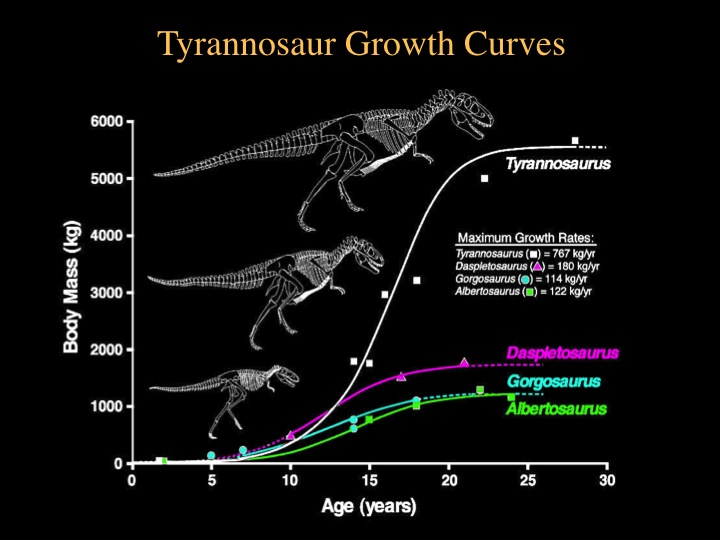
-
Showing that dinosaurs grew more considerably more rapidly than living reptiles and were lilely endothermic
-
Revealing that the largest and oldest T. rex (“Sue”) was just 28 years of age
-
Discovering the means by which dinosaurs attained
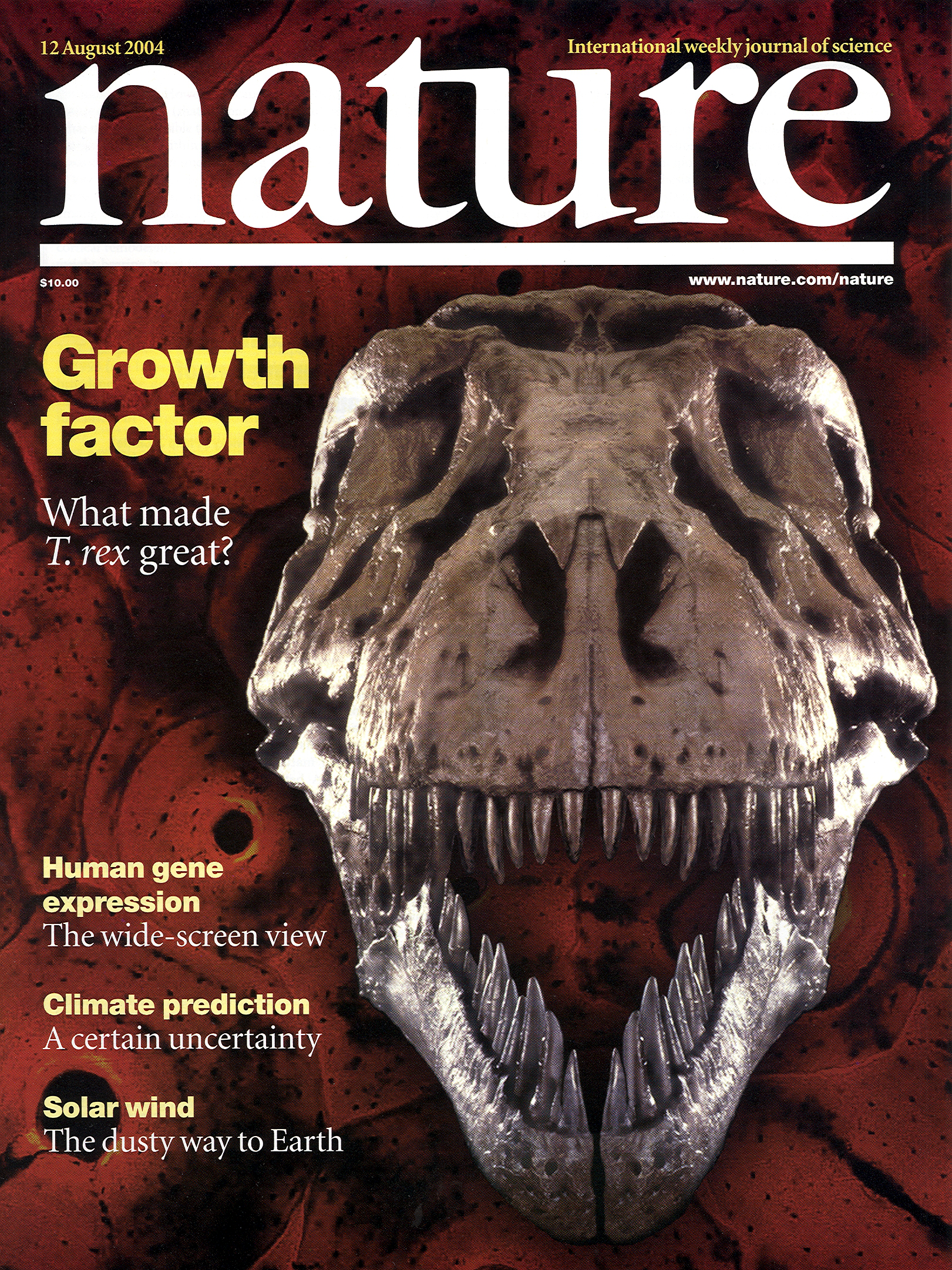 their iconic gigantism (heterochronic acceleration) using tyrannosaurs as a model system
their iconic gigantism (heterochronic acceleration) using tyrannosaurs as a model system
-
Making the first survivorship curves for dinosaur populations
- Showing that basal birds such as Archaeopteryx were physiologically just feathered dinosaurs
2. Crocodilian feeding biomechanics through bite-force experimentation.
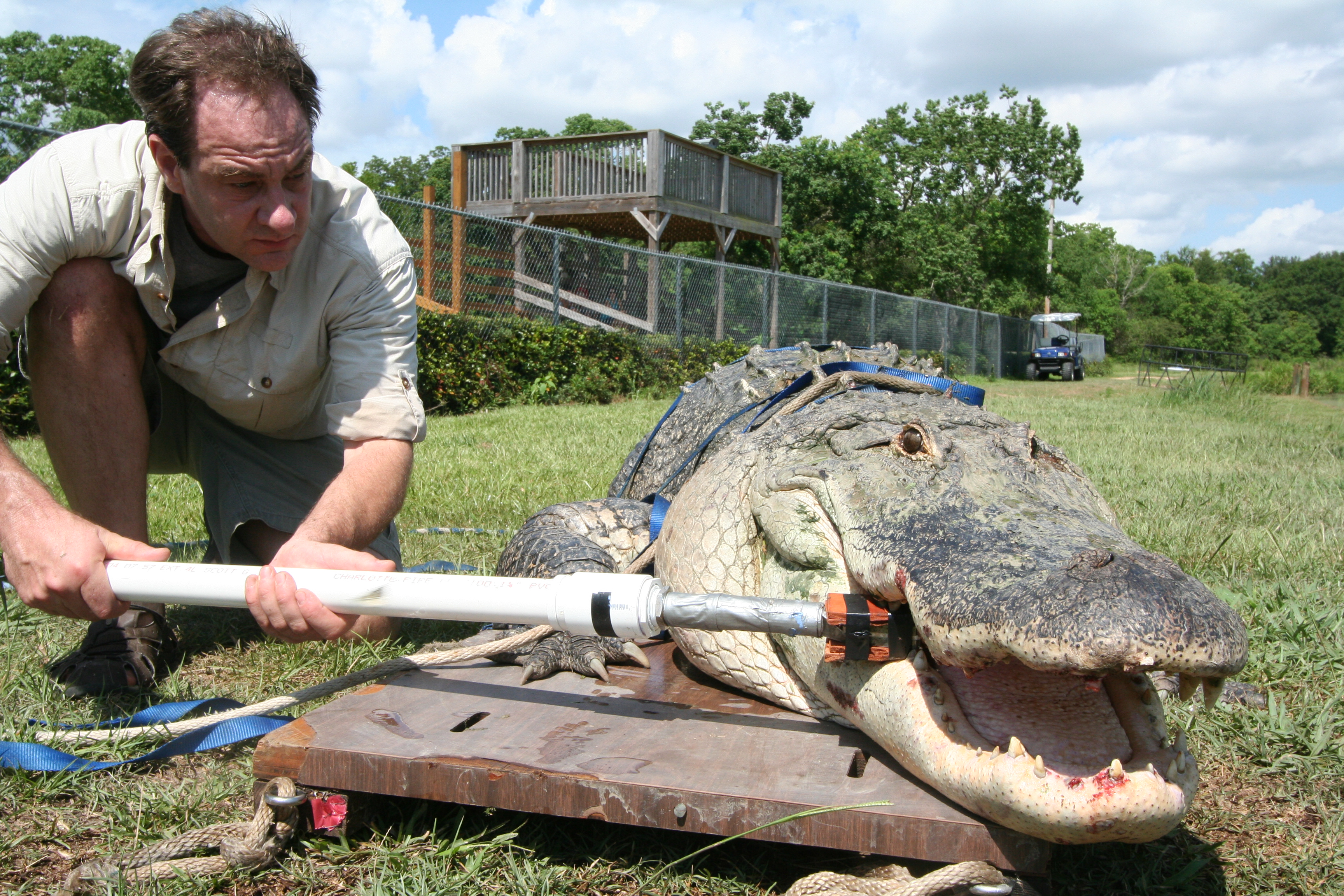
Major findings/advancements to date include:
- Developing bite force meters allowing the first measurements of crocodilian bite forces throughout development
- Measuring bite forces and tooth pressures in every species of
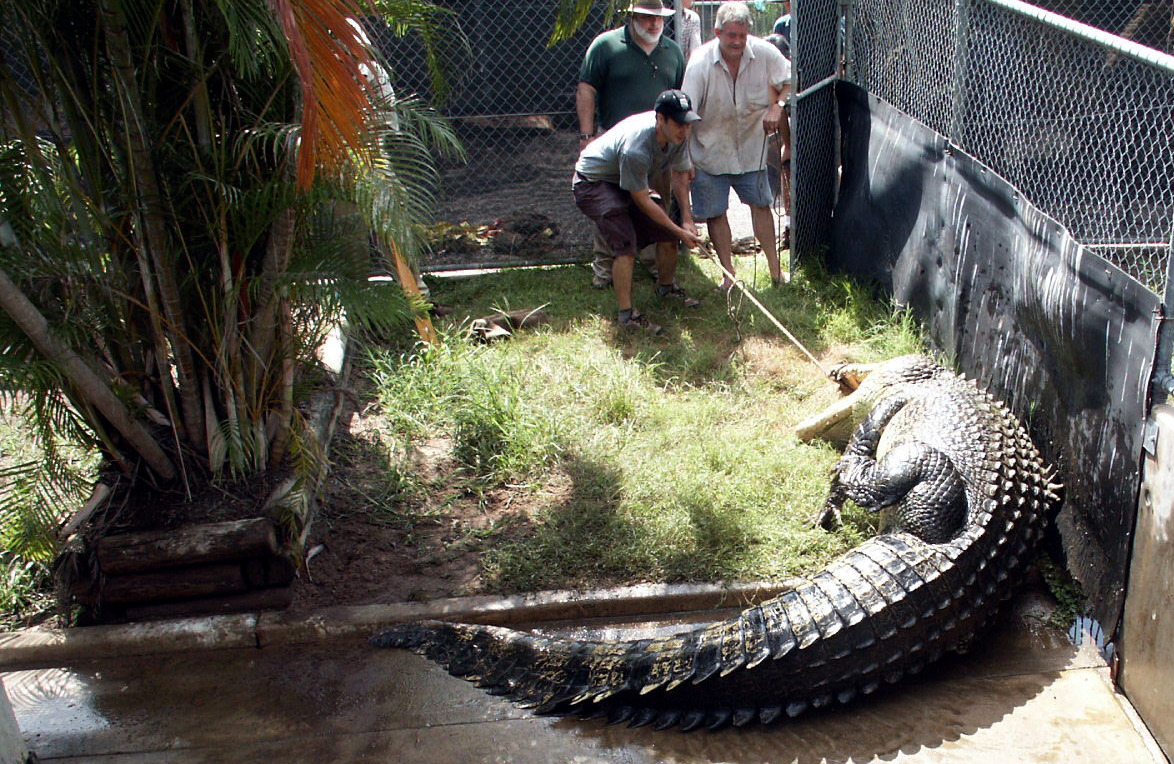 living crocodilian and showing bite force performance is pound for pound the same in any taxon regardless of diet
living crocodilian and showing bite force performance is pound for pound the same in any taxon regardless of diet
- Recording world record bite forces of 3,700 pounds and tooth pressure 360,000 pounds per square inch for a 17- foot saltwater crocodile in Australia
- Predicting 23,000 pound bite forces in giant extinct crocodilians
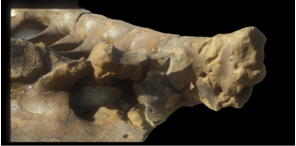 used to understand the ecological diversification of dinosaurs and other reptiles.
used to understand the ecological diversification of dinosaurs and other reptiles.
Major findings/advancements to date include:
- Determined dinosaur tooth replacement rates using daily forming von Ebners growth lines (duck-billed dinosaurs [hadrosaursids] wore down and shed their teeth in just 30-50 days and went through 3,300 teeth per year)
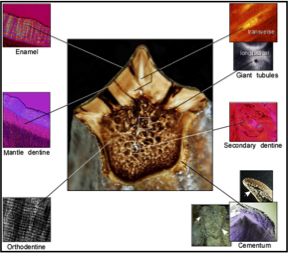
- Described the first T. rex bite marks from which their feeding style (puncture and pull) and bite forces were simulated using a mechanical testing frame
- Discovered that the mechanical wear properties of fossil teeth are preserved
- Showed that hadrosaurid and horned-dinosaur (ceratopsians) teeth are histologically and biomechanically more sophisticated than those of herbivorous mammals
- Conducte
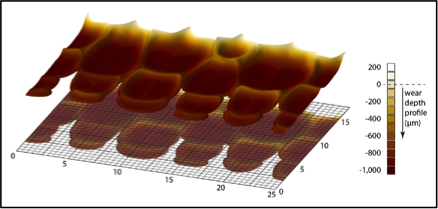 d simulations and empirical wear tests showing how hadrosaurid teeth self-wore to create horse-like grinding surfaces springboarding their ecological diversification
d simulations and empirical wear tests showing how hadrosaurid teeth self-wore to create horse-like grinding surfaces springboarding their ecological diversification
4. Paleo-Arctic Faunal Composition and Paleobiology. I conduct both neontological and
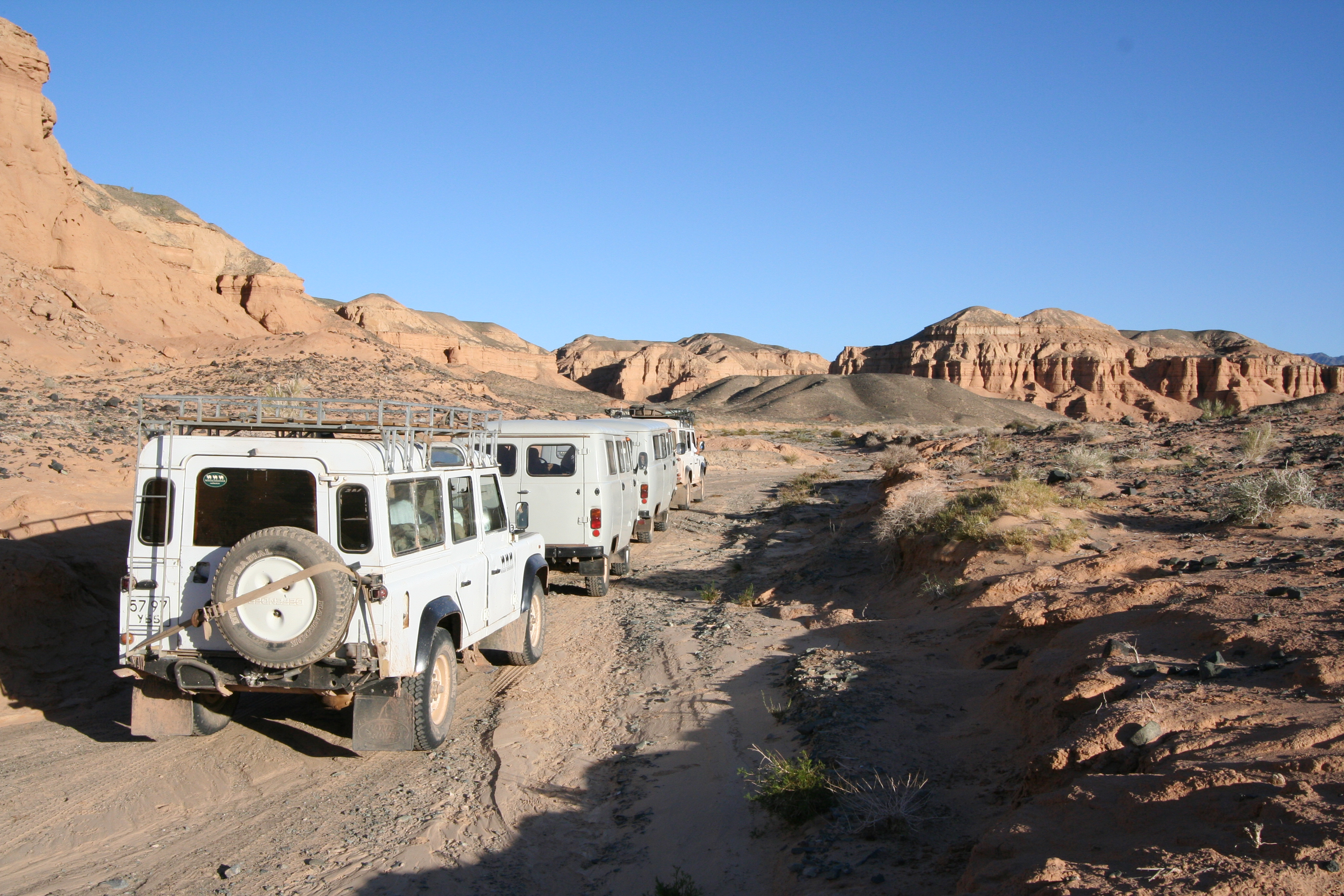 paleontological fieldwork and have worked on projects involving extant salmon, mudskippers, bears, and crocodilians and fossil amphibians, reptiles, and mammals. My current field program involves characterizing the vertebrate fauna of the Prince Creek Formation in the Arctic of Alaska and determining how dinosaurs coped with colder climates than they are typically
paleontological fieldwork and have worked on projects involving extant salmon, mudskippers, bears, and crocodilians and fossil amphibians, reptiles, and mammals. My current field program involves characterizing the vertebrate fauna of the Prince Creek Formation in the Arctic of Alaska and determining how dinosaurs coped with colder climates than they are typicallymetabolic status?).
Major findings/advancements to date include:
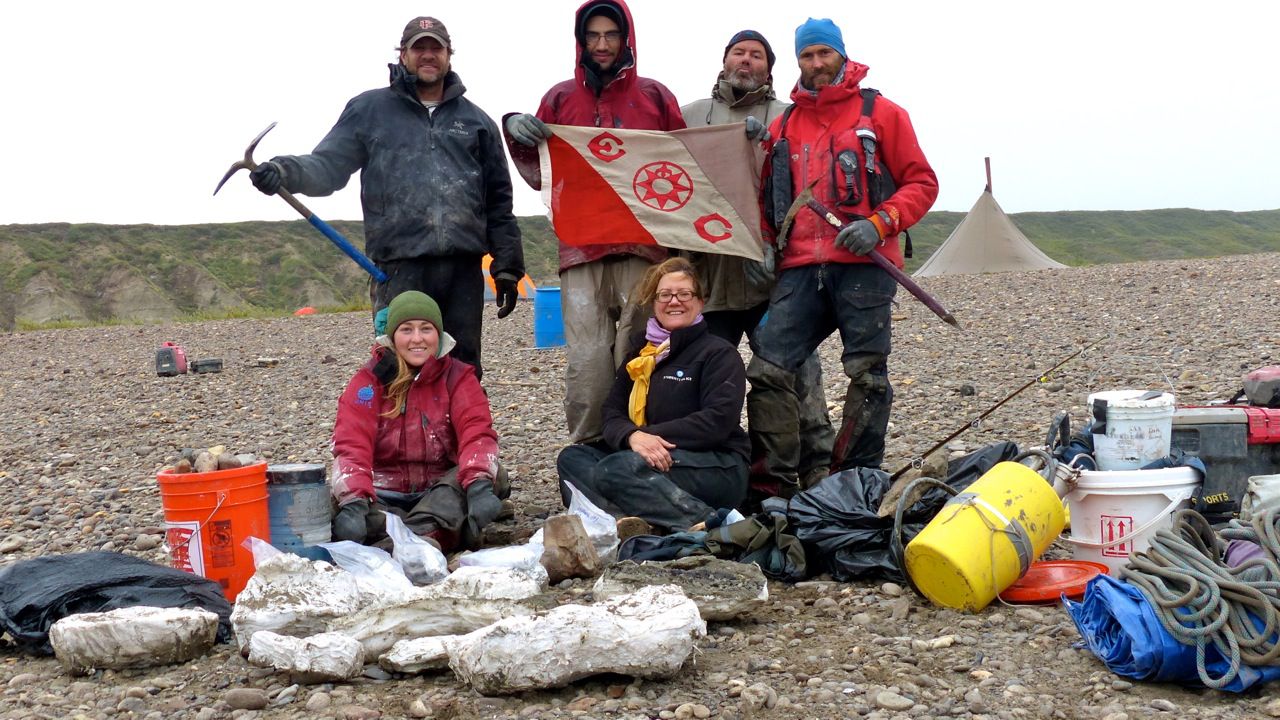
- Histological data suggesting the dinosaurs were year-round denizens.
- Discovery that nearly every dinosaur and mammal is new to science suggesting that the community represents a formerly unrecognized Arctic-adapted polar province.
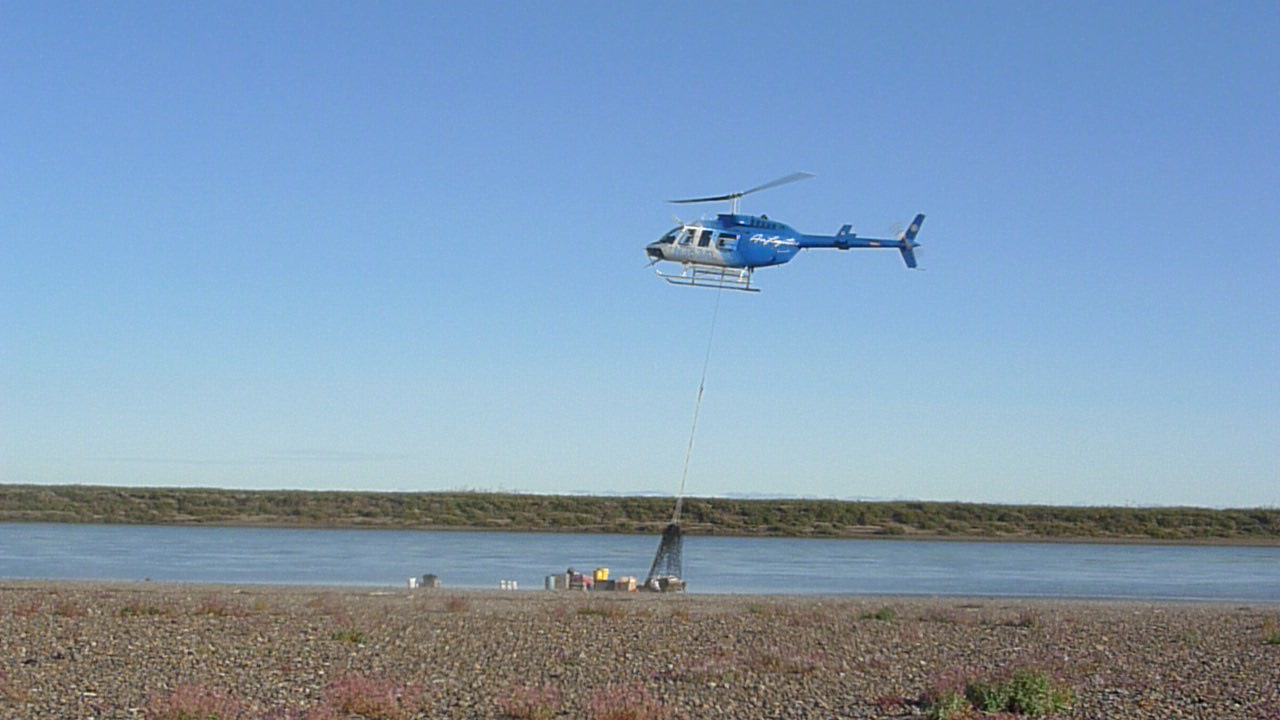
Selected Publications:
PROFESSIONAL PUBLICATIONS (peer-reviewed)
Erickson, G. M. 1995. Split carinae on tyrannosaurid teeth and implications of their development. Journal of Vertebrate Paleontology, 15:268-274.
Erickson, G. M. and K. H. Olson 1996. Bite marks attributable to Tyrannosaurus rex: preliminary description and implications. Journal of Vertebrate Paleontology, 16:175-178.
Erickson, G. M. 1996. Toothlessness in American alligators. Copeia. 1996:739-743.
Erickson, G. M. 1996. Daily deposition of incremental lines in Alligator dentine and the assessment of tooth replacement rates using incremental line counts. Journal of Morphology. 226:189-194.
Erickson, G. M., Van Kirk, S. D., Su, J., Levenston, M. E., Caler, W. E. and Carter, D. R. 1996. Bite-force estimation for Tyrannosaurus rex from tooth-marked bones. Nature, 382:706-708.
Erickson, G. M. 1996. Incremental lines of von Ebner in dinosaurs and the assessment of tooth replacement rates using growth line counts. Proceedings of the National Academy of Sciences, USA, 93:14623-14627.
Chin, K., Tokaryk, T. T., Erickson, G. M., and Calk, L. C. 1998. King-sized feces: a probable tyrannosaur coprolite from Saskatchewan. Nature, 393:680-682.
Erickson, G. M. and Brochu, C. A. 1999. How the terror crocodile grew so big. Nature, 398:205-206.
Sarin, V. K., Erickson, G. M., Giori, N. J., Bergman, A. G. and Carter, D. R. 1999. Coincident development of sesamoid bones and clues to their evolution. Anatomical Record (New Anatomist), 257:174-180. (Cover article)
Erickson, G. M. and Tumanova, T. A. 2000. Growth curve and life history attributes of Psittacosaurus mongoliensis (Ceratopsia: Psittacosauridae) inferred from long bone histology. Zoological Journal of the Linnean Society, 130:551-566.
Erickson, G. M. 2001. The bite of Allosaurus (News and Views). Nature, 409:987-988.
Erickson, G. M. Curry-Rogers, K., and Yerby, S. 2001. Dinosaur growth patterns and rapid avian growth rates. Nature, 412:429-433.
Erickson, G. M., Catanese, J. III, and Keaveny, T. 2002. Evolution of the biomechanical material properties of the femur. The Anatomical Record, 268:115-124.
Erickson, G. M, Lappin, A. K., and Vliet, K. A. 2003. The Ontogeny of bite-force performance in American alligator (Alligator mississippiensis). Journal of Zoology, London, 260:317-327.
Erickson, G. M. 2003. Using external vertebral growth rings to assess longevity in the Bengal monitor (Varanus bengalensis). Copeia, 2003:872-878.
Erickson, G. M., Ricqles, A. de, Buffrenil, V. de., Molnar, R. E., and Bayless, M. A. 2003. Vermiform bones and the evolution of gigantism in Megalania—How a reptilian fox became a lion. Journal of Vertebrate Paleontology, 23:966-970.
Erickson, G. M, Lappin, A. K., Parker, T., and Vliet, K. A. 2004. Comparison of bite-force performance between long-term captive and wild captured American alligators (Alligator mississippiensis). Journal of Zoology, London, 262:21-28.
Erickson, G. M., Makovicky, P. J., Currie, P. J., Norell, M. A., Yerby, S. A., and Brochu, C. A. 2004. Gigantism and comparative life-history parameters of tyrannosaurid dinosaurs. Nature, 430:772-775 (Cover article).
Clarke, J. A., Tambussi, C. P., Noriega, J. I., Erickson, G. M., and Ketcham, R. A. 2005. Definitive fossil evidence for the extant avian radiation in the Cretaceous. Nature, 433:305-308.
Curry-Rogers, K. and Erickson, G. M. 2005. Sauropod Histology: Microscopic Views on the Lives of Giants. Sauropod growth patterns. pp. 303-326, In: K. A. Curry Rogers and Wilson, J. (eds.)The Sauropods: Evolution and Paleobiology. Academic Press.
Erickson, G. M., Lappin. A. K., and Larson, P. 2005. Androgenous rex: The utility of chevrons for determining the sex of crocodilians and non-avian dinosaurs. Zoology, 108:277-286.
Erickson, G. M. 2005. Assessing dinosaur growth patterns: A microscopic revolution. Trends in Ecology and Evolution, 20:677-684.
Xu, X., Clark, J. M., Forster, C. A., Norell, M. A., Erickson, G. M., Eberth, D., Jia, C. and Qi, Z. 2006. A primitive tyrannosauroid dinosaur from the Late Jurassic of China with an exaggerated cranial crest. Nature, 439:715-718.
Nesbitt, S. J., Turner, A. H., Norell, M. A., Erickson, G. M. 2006. Prey choice and cannibalistic behavior in the theropod Coelophysis. Biology Letters (The Royal Society, London), 2:611-614.
Erickson, G. M., Currie, P. J., Inouye, B. D. and Winn, A. A. 2006. Tyrannosaur life tables: The first look at non-avian dinosaur population biology. Science, 313:213-217.
Clarke, J. A., Tambussi, C. P., Noriega, J. I., Erickson, G. M., and Ketcham, R. A. 2006. Corrigendum: Definitive fossil evidence for the extant avian radiation in the Cretaceous. Nature, 444:780.
Erickson, G. M., Curry Rogers, K., Varricchio, D. J., Norell, M. A., Xu, X. 2007. Growth patterns in brooding dinosaurs reveals the timing of sexual maturity in non-avian dinosaurs and genesis of the avian condition. Biology Letters (Royal Society), 3:558-561 (Cover article).
Turner, A. H., Pol, D., Clarke, J. A., Erickson, G. M., and Norell, M. A. 2007. A basal dromaeosaurid and size evolution preceding avian flight. Science, 317:1378-1381.
Varricchio, D. V., Moore, J. R., Erickson, G. M., Norell, M. A., Jackson, F. D. and Borkowski, J. L. 2008. Avian paternal care had dinosaur origin. Science, 322:1826-1828.
Xu, X., Zhao, Q., Norell, M. A., Sullivan, C., Hone, D., Erickson, G. M., Wang, X., Han, F. and Guo, Y. 2009. A new feathered maniraptoran dinosaur fossil that fills a morphological gap in avian origin. Chinese Science Bulletin, 54:430-435.
Erickson, G. M., Rauhut, O. and Norell, M. A., Zhonghe, Z., Turner, A. H., Inouye, B. D. Hu, D. and Norell, M. A. 2009. Was dinosaurian physiology inherited by birds? Reconciling slow growth in Archaeopteryx. PLoS One, 4(10)e7390. Doi:10.1371/journal.pone.0007390.
Xu, X., Clark, J. M. Jinyou, M., Choiniere, J., Forster, C. A., Erickson, G. M., Hone, D.W.E., Sullivan, C. Eberth, D. A., Nesbitt, S., Qi, Z., Hernandez, R., Cheng-kai, J. Feng-lu, H. and Yu, G. 2009. A Jurassic ceratosaur from China helps clarify avian digital homologies. Nature, 459:940-944.
Erickson, G. M., Makovicky, P. J., Inouye, B. D., Zhou C.-F., and Gao, K. 2009. Life table for Psittacosaurus lujiatunensis: The first glimpse into ornithischian dinosaur population biology. The Anatomical Record, 292:1514-1521.
Brusatte, S. L., Carr, T. D., Erickson, G. M., Bever, G. S., and Norell, M. A. 2009. A long-snouted, multi-horned tyrannosaurid from the Late Cretaceous of Mongolia. Proceedings of the National Academy of Sciences, USA, 41:17261-17266.
Bell, A.K., Chiappe, L.M., Erickson, G.M., Suzuki, S., Watabe, M., Barsbold, R. and Tsogtbaatar, K. 2010. Description and ecologic analysis of Hollanda luceria, a Late Cretaceous bird from the Gobi Desert (Mongolia). Cretaceous Research, 31:16-26.
Butler, R. J., Galton, P. M. Porro, L. B. Chiappe, L. M., Henderson, D. M., and Erickson, G. M. 2010. Lower limits of ornithischian dinosaur body size inferred from a new Upper Jurassic heterodontosaurid from North America. Proceedings of the Royal Society B: Biological Sciences, 277:375-381.
Makovicky, P., Li, D., Gao, K. Lewin, M., Erickson, G. M., and Norell, M. A. 2010. A giant ornithomimid from the Early Cretaceous of China. Proceedings of the Royal Society B: Biological Sciences, 277:191-198.
Pfaller, J. B., Herrera, N. D., Gignac, P. M., and Erickson, G. M. 2010. Ontogenetic scaling of cranial morphology and bite-force generation in the loggerhead musk turtle. Journal of Zoology, 280:280-289.
Gignac, P., Makovicky, P., and Erickson, G. M. and Walsh, R. P. 2010. A description of Deinonychus antirrhopus bite marks and estimates of bite force using tooth indentation simulations. Journal of Vertebrate Paleontology, 30:169-177.
Erickson, G. M., Currie, P. J., Inouye, B. D. and Winn, A. A. 2010. A revised Life table and survivorship curve for Albertosaurus sarcophagus based on the Dry Island mass death assemblage. Canadian Journal of Earth Sciences, 47:1269-1275.
Longrich, N., Horner, J. R., Erickson, G. M., and Currie, P. J. 2010. Cannibalism in Tyrannosaurus rex. PLoS One, 5: e13419. doi:10.1371/journal.pone.0013419
Brusatte, S. L, Norell, M. A., Carr, T. D., Erickson, G. M., Hutchinson, J. R., Bever, G. S., Balanoff, A. M., Xu, X., Makovicky, P. J., and Choiniere, J. N. 2010. Tyrannosaur paleobiology: new research on ancient exemplar organisms. Science, 329:1481-1485.
Pfaller, J. B., Gignac, P. M., and Erickson, G. M. (2011) Ontogenetic changes in jaw-muscle architecture facilitate durophagy in the turtle Sternotherus minor. Journal of Experimental Biology, 214:1655-1667.
Erickson, G. M. and Druckenmiller, P. S. (2011) Longevity and growth rate estimates for a polar dinosaur: A Pachyrhinosaurus (Dinosauria: Neoceratopsia) specimen from the North Slope of Alaska showing a complete developmental record. Historical Biology, 24:327-334.
Erickson, G. M., Gignac, P. G. Steppan, S., Lappin, K., Vliet, K., Inouye, B. D., Webb, G., and Brueggen, J. (2012) Insights into the ecology and evolutionary success of crocodilians revealed through bite force and tooth pressure experimentation. PLoS One. 7(3): e31781. doi:10.1371/journal.pone.0031781
Erickson, G. M., Krick, B. A., Hamilton, M., Bourne, G. R., Norell, M. A., Lilleodden, E., and Sawyer, W. G. (2012) Complex Dental Structure and Wear Biomechanics in Hadrosaurid Dinosaurs. Science, 338:510-514.
Watanabe A., Erickson, G. M. and Druckenmiller P. S. (2013) An ornithomimosaur from the Upper Cretaceous Prince Creek Formation of Alaska. Journal of Vertebrate Paleontology, 33:1169-1175.
Brusatte, S. L., Vremir, M., Csiki, Z., Norell, M. A., Turner, A. H., Watanabe, A., Erickson, G. M. and Norell, M. A. (2013). The osteology of Balaur bondoc, an island-dwelling dromaeosaurid (Dinosauria: Theropoda) from the Late Cretaceous of Romania. Bulletin of the American Museum of Natural History, 374:1-100.
Choiniere, J., Clark, J. M., Xu, X., Forster, C., Norell, M. A., Eberth, D. A., and Erickson, G. M. (2013) A juvenile specimen of a new coelurosaur (Dinosauria: Theropoda) from the Middle–Late Jurassic Shishugou Formation of Xinjiang, People’s Republic of China. Journal of Systematic Palaeontology, 12(2):177-215 DOI:10.1080/14772019.2013.781067
Zelenitsky, D. K.; Therrien, F.; Erickson, G. M.; Debuhr, C. L.; Kobayashi, Y.; Eberth, D. A.; Hadfield, F. (2012). Feathered non-avian dinosaurs from North America provide insight into wing origins. Science, 338: 510-514.
Uhen, M., Barnosky, A., Bills, B., Blois, J., Carrasco, M., Carrano, M., Erickson, G., Eronen, J., Fortelius, M., Graham, R., Grimm, E., O’Leary, M., Mast, A., Piel, W., and Polly, D. (2013) From card catalogs to computers: Databases in vertebrate paleontology. Journal of Vertebrate Paleontology, 33:13-28.
Brusatte, S.L., Vremir, M., Watanabe, A., Csiki-Sava, Z., Naish, D., Dyke, G., Erickson, G. M., and Norell, M. A. (2013) An infant ornithopod dinosaur tibia from the Late Cretaceous of Sebes, Romania. Terra Sebus. Acta Musei Sabesiensis, 5:627-644.
Rowe, K. G., Erickson, G. M., Sawyer, W. G. and Krick, B. A. (2014). Evolution in surfaces: Interaction of topography with contact pressure during wear of composites including dinosaur dentition. Tribology Letters, 54: 249-255. DOI:10.1007/s11249-013-0271-2
Erickson, G. M. and Zelenitsky, D. K. (2014) Osteohistology of Hypacrosaurus stebengeri teeth throughout onotgeny with comments on wear induced form and function. Pp. 422-432 In: Hadrosaurs; Eberth, D. and Evans, D. (eds.) University of Indiana Press, Bloomington.
Erickson, G. M. (2014) On dinosaur growth. Annual Review of Earth and Planetary Sciences. 42: 675-697.
Erickson, G. M., Gignac, P. M., Lappin, A. K., Vliet, K. A., Brueggen, J. D. and Webb, G. J. W. (2014), A comparative analysis of ontogenetic bite-force scaling among Crocodylia. Journal of Zoology, 292:48–55. DOI: 10.1111/jzo.12081
Xu, X, Zhou, Z, Dudley, R., Mackem, S., Chuong, C-M, Erickson, G. M. and Varricchio, D. J. (2014) An integrative approach to understanding bird origins. Science 346 (6215): DOI:10.1126/science.1253293
Erickson, G. M., Makovicky, P. J., Inouye, B. D., Zhou, C-F., and Gao, K-Q. (2015) Flawed analysis? A response to Myhrvold. The Anatomical Record: 288(10):1669-1672. DOI:10.1002/ar.23187
Erickson, G. M., Sidebottom, M., Kay, D. I. K., Turner, K., Nathan, I. P. Norell, M. A., Sawyer, W. G. Krick, B. A. (2015) Wear biomechanics in the slicing dentition of the giant horned dinosaur Triceratops. Science Advances 1(5): DOI 10.1126/sciadv.1500055
Erickson, G. M. Curry-Rogers, K., and Yerby, S. (2015). Corrigendum: Dinosaur growth patterns and rapid avian growth rates. Nature: 531. DOI 10.1038/nature16488
Erickson, G. M., Makovicky, P. J., Currie, P. J., Norell, M. A., Yerby, S. A., and Brochu, C. A. (2015). Corrigendum: Gigantism and comparative life-history parameters of tyrannosaurid dinosaurs. Nature: 531. DOI 10.1038/nature16487
Gignac, P. M. and Erickson, G. M. (2015) Ontogenetic changes in dental form and tooth pressures facilitate developmental niche shifts in American alligators. Journal of Zoology: 295:132-142. DOI:10.1111/jzo.12187
Mori, H., Druckenmiller, P. D., and Erickson G. M. (2016) A new Arctic hadrosaurid from the Prince Creek Formation (lower Maastrichtian) of northern Alaska. Acta Palaeontologica Polonica: 6(1): 15-32. DOI:http://dx.doi.org/10.4202/app.00152.2015 (Editor’s Choice)
Prieto-Marquez, A., Erickson, G. M., and Ebersole, J. (2016) A primitive hadrosaurid from southeastern North America and the origin and early evolution of ‘duck-billed’ dinosaurs. Journal of Vertebrate Paleontology: 36(2): tba. DOI:10.1080/02724634.2015.1054495
Erickson, G. M., Sidebottom, M., Curry, J., Kay D. A., Kuhn-Hendricks, S., Norell, M. A, Sawyer, W. G. and B. A. Krick (2016) Paleo-tribology: Development of wear measurement techniques and a three-dimensional model revealing how grinding dentitions self-wear to enable functionality. Surface Topography: Metrology and Properties: 4. DOI: org/10.1088/2051-672X/4/2/024001
Gignac, P. M, and Erickson, G. M. (2016) Ontogenetic bite-force modeling of Alligator mississippiensis: Implications for dietary transitions in a large-bodied vertebrate and the evolution of crocodylian feeding. Journal of Zoology. 299(4): 229-238. DOI:10.1111/jzo.12349 (Cover article)
Prieto-Marquez, A., Erickson, G. M., and Ebersole, J. (2016) Anatomy and osteohistology of the basal hadrosaurid dinosaur Eotrachodon from the uppermost Santonian (Cretaceous) of southern Appalachia. PeerJ 4:e1872; DOI 10.7717/peerj.1872
Druckenmiller, P. D., Mori, H., Erickson, G. M. (2016). Preservation of Arctic dinosaur remains from the Prince Creek Formation (Alaska, USA): A reply to Fiorillo. Acta Palaeontologica Polonica: 61(1): 174.
Erickson, G. M., Zelenitsky, D. K., Kay, D. I. and Norell, M. A. (2017) Dinosaur incubation periods directly determined from growth line counts in embryonic teeth show reptilian-grade development. Proceedings of the National Academy of Sciences, USA: 114(3): 540-545. (Online feature article)
Gignac, P. M., and Erickson, G. M. (2017). The biomechanics behind extreme osteophagy in Tyrannosaurus rex. Nature: Scientific Reports: 7: doi:10.1038/s41598-017-02161-w
Kolmann, M. A., Grubbs, R. D., Huber, D. R., Fisher, R., Lovejoy, N. R., Erickson, G. M. (2018). Intraspecific variation in feeding mechanics and bite force in durophagous stingrays. Journal of Zoology: 10.1111/jzo.12530.
Norell, M. A., Balanoff, A. M., Barta, D. E. and Erickson G. M. (2018) A second specimen of Citipati osmolskae with a nest of eggs from Ukhaa Tolgod, Omnogov Aimag, Mongolia. American Museum Novitates: 3899: 1-44. http://digitallibrary.amnh.org/handle/2246/6858
O'Connor, J, Erickson, G.M., Norell, M. A., Bailleul, A., Hu H. and Zhou, Z. (2018). Medullary bone in an Early Cretaceous enantiornithine bird and discussion regarding its identification in fossils. Nature Communications: 9(1): 1-8: DOI: 10.1038/s41467-018-07621-z
Anderson, K. L., Druckenmiller, P. S., Erickson, G. M. and Maxwell, E.E. (2018). Skeletal microstructure of Stenopterygius quadriscissus (Reptilia, Ichthyosauria) from the Posidonienschiefer (Posidonia Shale, Lower Jurassic) of Germany. Paleontology: 1-17. DOI: doi.org/10.5061/dryad.032cq64
Gignac, P. M., O’Brien, H. D., Turner, A. H., and Erickson, G. M (2019). Feeding in crocodylians and their relatives: exemplars of adaptive versatility. Pp. tba In: Feeding in Vertebrates: Anatomy, Biomechanics, and Evolution; Bels, V. (ed.) Academic Press, San Diego.
O’Brien, Lynch, L0. M., Vliet, K. A., Brueggen, J., Erickson, G. M., and Gignac, P. M. (2019). Crocodylian head width allometry and a phylogenetic prediction of body size in extinct crocodyliforms. Integrative Organsimal Biology: 1(1) obz006 https://doi.org/10.1093/iob/obz006
Eberle, J. J., Clemens, W. A., McCarthy, P.J.,Fiorillo, A. R., Erickson, G. M. and Druckenmiller, P. S. (2019). Northernmost record of Metatheria: A new Late Cretaceous pediomyid from the North Slope of Alaska. Journal of Systematic Palaeontology: DOI: 10.1080/14772019.2018.1560369
Persons IV, W. S, Currie, P. J. and Erickson, G. M. (2019). An Older and Exceptionally Large Adult Specimen of Tyrannosaurus rex. Anatomical Record: https://doi.org/10.1002/ar.24118
Napoli, J. G., Hunt, T., Erickson, G. M. and Norell, M. A. (2019). Supplemental material for Psittacosaurus amitabha, a new species of ceratopsian dinosaur from the Ondai Sayr locality, central Mongolia. American Museum Novitates: no. 3932. https:/doi.org/10.5531/sd.sp.34.
Atterholt, J., Poust, A. W., Erickson, G. M. and O’Connor, J. K. (2021). Intraskeletal osteohistovariability reveals complex growth strategies in a Late Cretaceous enantiornithine. Frontiers in Earth Science — Section Paleontology: https://doi.org/10.3389/feart.2021.640220.
Wooller, M. J., Bataille, C., Druckenmiller, P. Erickson, G. M., Groves, P., Haubenstock, M., Howe, T., Irrgeher, J., Mann, D., Moon, K., Potter, B. A., Prohaska, T., Rasic, J., Reuther, J., Shapiro, B., Spaleta, K. J. and Willis, A. D. (2021). Lifetime mobility of an Arctic woolly mammoth. Science: 373 (6556) 806-808. DOI: 10.1126/science.abg1134.
Druckenmiller P. S., Erickson, G. M., Brinkman, D. S. Brown, C. M., and Eberle, J. E. (2021). Nesting at extreme polar latitudes by non-avian dinosaurs. Current Biology: 31(16) 3469-3478. DOI: https://doi.org/10.1016/j.cub.2021.05.041.
Steppan, S. A., Meyer, A. A., Barrow, L. N., Alhajeri, B. D. AL-Zaidan, A.,A. Y., Gignac, P. M. and Erickson G. M. (2022). Phylogenetics and the evolution of terrestriality in mudskippers (Gobiidae: Oxudercinae). Molecular Phylogenetics and Evolution, 169 (107416). https://doi,org/10.1016/j.ympev.2022.107416.
Fabbri, M., Navalón, G., Benson, R.B.J., Pol, D., O’Connor, J., Bhullar, Bhart-Anjan S., Erickson, G. M., Norell, M. A., Orkney, A., Lamanna, M. C., Zouhri, S., Becker, J., Emke, A., Dal Sasso, C., Bindellini, G., Maganuco, S., Auditore, M., and Ibrahim, N. (2022). Subaqueous foraging among carnivorous dinosaurs. Nature: 603 (7903): 852–857. https://doi.org/10.1038%2Fs41586-022-04528-0.
Fabbri, M., Navalón, G., Benson, R.B.J., Pol, D., O’Connor, J., Bhullar, Bhart-Anjan S., Erickson, G. M., Norell, M. A., Orkney, A., Lamanna, M. C., Zouhri, S., Becker, J., Emke, A., Dal Sasso, C., Bindellini, G., Maganuco, S., Auditore, M., and Ibrahim, N. (Preprint 2022: In Review). Sinking a giant: quantitative macroevolutionary comparative methods debunk qualitative assumption. Nature: doi: https://doi.org/10.1101/2022.05.05.490811.
Erickson, G. M., Watanabe, A., Wellspring, K., Nesbitt, S., Kuhn-Hendricks, S. and Norell, M. A. Revisiting Hitchcock’s “bird tracks”; the earliest evidence for feathered dinosaurs? (Accepted). American Museum Novitates: tba.
Stewart, D. G., Druckenmiller, P. S., Erickson, G. M., Capps, D., Benowitz, J., May, K. C. and McCarthy P. J. (In Press). Vertebrate ichnology and paleoenvironmental associations of Alaska’s largest known dinosaur tracksite in the Cretaceous Cantwell Formation (Maastrichtian) of Denali National Park and Preserve. Cretaceous Research: tba.
Longrich, N. R., Makovicky, P. J., Tokaryk, T., Cooper, D. M. L., Saitta, E., Erickson, G. M. Szekely, T. and Snively, E. (In Revision). Hatchlings of Tyrannosaurus rex and the evolution of dinosaur reproductive strategies. Science: tba.
PROFESSIONAL PUBLICATIONS (non-peer reviewed)
Erickson, G. M. 1997. Von Ebner incremental growth lines. pp. 4-6, In: Currie, P. J. and Padian, K. (eds.). Encyclopedia of Dinosaurs. Academic Press, San Diego.
Erickson, G. M. 1997. Age determination of dinosaurs. pp. 781-782, In: Currie, P. J. and Padian, K. (eds.). Encyclopedia of Dinosaurs. Academic Press, San Diego.
Erickson, G. M. 1997. Tooth replacement patterns. pp. 739-740, In: Currie, P. J. and Padian, K. (eds.). Encyclopedia of Dinosaurs. Academic Press, San Diego.
Erickson, G. M. 1999. Breathing life into T-rex. Scientific American, September: 32-39. (Cover article).
Erickson, G. M. 1999. The Dechronization of Sam Magruder by George Gaylord Simpson, a commentary. Scientific American, September: 52-53.
Erickson, G. M. 1999. Breathing life into Tyrannosaurus rex. pp. 267-275, In: Paul, G. S. (ed.) Scientific American Book of Dinosaurs , St Martin’s Press, New York.
Erickson, G. M. 2002. Ask the experts: When T. rex fell, how did it get up, given its tiny arms? Scientific American 287: 95 (also Scientific American Online--posted Feb. 4, 2002).
Erickson, G. M. 2002. Ask the experts: What are the odds of a dead dinosaur becoming fossilized? Scientific American Online—posted Sept. 16, 2002.
Lappin, A. K., Erickson, G. M., and K.A. Vliet. 2002. Bite-force performance in crocodilians: a feasibility study on the American alligator, Alligator mississippiensis. Pages 158-164 in Proceedings of the 16th Working Meeting of the Crocodile Specialist Group, IUCN - The World Conservation Union, Gland, Switzerland and Cambridge, United Kingdom.
Erickson, G. M. 2004. Breathing life into Tyrannosaurus rex (update of 1999 article). Scientific American (Special Issue, March).
Erickson, G. M. 2005. Dinosaur Growth Patterns. McGraw-Hill 2005 Yearbook of Science and Technology. McGraw-Hill, NY.
Erickson, G. M. 2007. Bad to the bone --Tyrannosaurus rex bites again. In: Holtz, T. R. Jr. (ed.) Dinosaurs, Random House Publishing, NY.
Erickson, G. M. 2009. Paleontologists in academia. In: Stein, W. W. The Top 256 Rules of Paleontology. Dragon’s Claw Press, Belle Fourche. Pp. 229.
Erickson, G. M. 2009. The population biology of Tyrannosaurus rex. In: Hasegawa, Y. (ed.) Dinosaur Expo 2009—The Miracle of Deserts. Nikkei National Geographic Inc., Tokyo. Pp. 152-153.
Erickson G. M. 2009. Dinosaurs: The Model System for Evolution. In: Travis, J. and Ruse, M. (eds.): Evolution, The First Four Billion Years, Harvard University Press. Pp. 517-522.
Erickson, G. M. 2010. Review of: Introduction to the Paleobiology and the Fossil Record, Benton, M. J. and Harper, A. T. The Quarterly Review of Biology: 85: 89-90.
Erickson, G. M. and Gignac, P. M. 2010. Bite forces for Toyotamaphymeia inferred from the biomechanics of living crocodilians. In: Kobayashi, Y. (Ed.) A Giant Japanese Crocodile Machikanewan, University of Osaka Press. Pp. 78-79.
Rauhut, O. W. M. and Erickson, G. M. 2010. Archaeopteryx - der 'Urmeter' der Vogelevolution (Archaeopteryx - the “yardstick’ of bird evolution). Jahresbericht 2009 und Mitteilungen der Freunde der Bayerischen Staatssammlung für Paläontologie und historische Geologie e.V.1-12.
Erickson, G. M. (2012) Robin Reid: an influential figure in the development of modern osteohistological analyses for the study of dinosaurian biology. In: Farlow, J. O. and Brett-Surman, M. K. (Eds.) The Complete Dinosaur, 2nd Ed. Indiana University Press, Bloomington, Pp. 621-623.
Erickson, G. M. 2014. Breathing life into T. rex. Scientific American (Dinosaurs--Special Edition, Vol 23, May, 38-45).
Druckenmiller, P. S., Erickson, G. and Chase, J. M. (2013/2014) Age of the Arctic Dinosaurs. The Explorers Journal 91(4):17-21.
PROFESSIONAL PUBLICATIONS – BOOKS (non-peer reviewed)
Erickson, G. M. 2002-2009 editions. Paleobiology of Dinosaurs. Hayden McNeil Press. Plymouth,
MI. 120 pp.
Erickson, G. M. 2011-2015 editions. Zoologia Dinosauriorum: A 21th Century Perspective on Dinosaur Biology. Hayden McNeil Press. Plymouth, MI. 136 pp.
Erickson, G. M. 2016-2022. Living with Dinosaurs: The Rise, Reign, and “Demise” of the Fearfully Great Reptiles. Hayden McNeil Press. Plymouth, MI. 138 pp.
Erickson, G. M. 2018. The Baddest Bite. Scientific American 318(3).
